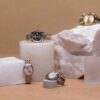Bronwen K. Bradshaw
Features Writer
The name Chanel has been a part of popular culture for decades. It has appeared on billboards and in commercials, magazines, and films. From designer perfumes to tweed matching sets to handbags, the design company has been a luxury staple since the 1920s. Chanel has been known for simplicity and a revolutionary style of women’s attire since Coco Chanel created the brand. Though the name Chanel is common in the fashion world, there is more to the story behind the French designer.
Chanel was born Gabrielle in Samur, France, in 1883. After her mother’s death when Chanel was 11 years old, she and her sisters went to an orphanage run by the Congregation of the Sacred Heart of Mary in Aubazine, France. According to Time magazine, the habits the nuns wore became an inspiration for Chanel’s sleek and architectural clothing design style. At age 18, Chanel left the orphanage and moved to Moulins, France, where she applied her sewing skills from the orphanage as a seamstress during the day. She became a nighttime cabaret singer, which is when she started going by “Coco,” which she claimed was a nickname from her father. Some speculate it came from the song “Qui qu’a vu Coco?” (“Who Has Seen Coco?), which she often performed. Chanel met many French fashion entrepreneurs while performing, including her lover and first collaborator, Étienne Balsan.
After moving in with Balsan, Chanel began designing hats that soon grew popular with French women, which she sold starting in 1910 from a small boutique in Paris. Chanel befriended Balson’s friend Arthur Capel. The two began an affair, and Capel helped finance Chanel’s second business, which she opened in Deauville, France, in 1913, to sell hats and clothing.
Chanel utilized fabrics often used for men’s underwear to create a more breathable, functional wardrobe for French women. She was also one of the first designers to make pants for women. Chanel’s designs were like nothing else in fashion then, and she became an icon for encapsulating her personality and aesthetic with her garments.
However, her life has its share of controversy. Chanel closed her stores in 1939, which led to more than 4,000 women workers losing their jobs. Some accounts suggest Chanel blamed the outbreak of war but closed her stores in direct defiance of those workers striking for better wages in the years before World War II. She lived in the Ritz Paris during the German occupation of France, where she began a relationship with Nazi operative Hans Günther von Dincklage. Chanel fled to Switzerland over concerns about being charged in France for her Nazi collaborations. She was released after interrogation, and there are conflicting historical documents showing her involvement in German plans and potential membership in the French Resistance. Ultimately, her longtime friend Winston Churchill kept her from facing any punishment.
After being out of business for over a decade by the mid-1950s, Chanel sought a comeback. Some critics were initially wary of Chanel’s new line of garments, but the Chanel suit became an iconic look for women throughout the late 1950s and early 1960s. Her redesigned luxury handbag became another stunning success. Although she didn’t have complete control over her fragrance — the ubiquitous Chanel No. 5 — a new business arrangement ensured that Chanel saw enough profit to make her one of the world’s wealthiest women. Marilyn Monroe’s association with the perfume brought it additional exposure, as did Jackie Kennedy’s pink Chanel suit that she was wearing at the time her husband, President John F. Kennedy, was shot in 1963 in Dallas.
Chanel died in 1971 at 87 years old without making plans for her company’s continued operation. Many people wondered who would replace Chanel as the brand’s artistic director. Prolific designer Karl Lagerfeld accepted the position in 1983 and provided a new vision that brought triumphant success as he tapped into Chanel’s vision but with a new and modern lens.
Coco Chanel was a pioneer of luxury design and helped break the mold of women’s garments during her lifetime. However, she left behind a complicated legacy even as the brand has carried on her iconic style.
Categories: featured, Features
This post was originally published on this site be sure to check out more of their content.





